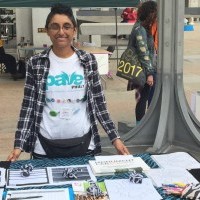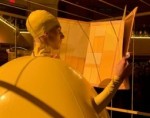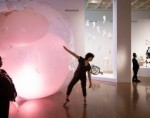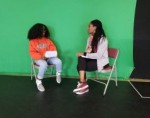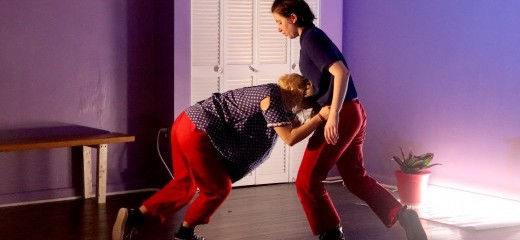
UMA Artists in Residence
by Preeti Pathak
I recently had the chance to delve into process with Maddie Hopfield* and Kayla Bobalek: creators and performers of yes, this is she, which I attended at Urban Movement Arts, a multi-use dance space that focuses on Hip Hop. The piece is a culmination of Hopfield and Bobalek’s year-long residency at UMA. yes, this is she is quirky, funny, kinetic, kooky. I can’t neatly place the show in a particular box. It’s a dance-play-audio experience. We start by listening to the performers’ voicemail message, garbled and hard to hear. There is a beautiful purply-pink light that washes over the stage. A door cracks open. An arm emerges, darting in and out at different heights. Space bop jazz plays—a mix of a wind quartet and an organ. A handheld vacuum begins to clean off the arm, and the audience erupts in laughter.
The performers finally enter the stage, moving in unison as one intertwined body attached front-to-back. Hopfield gestures frantically while Bobalek moves smoothly. I feel connection and disconnection through the interactions of their bodies. They work together to turn a lamp on, one set of hands pointing out the direction to take while the other set fumbles to complete the task. They separate and move about the stage like great balls of energy, darting, tip-toeing, frolicking in circles. Finally they come together in a stand-still with the sounds of heavy breathing as they gasp for air.
Throughout the show we hear different recordings, including a classic tax-fraud robocall scam. We also listen to a conversation between Bobalek and her grandfather, who has fallen prey to a scam, losing all his money. Sometimes we can hear clearly, at other times the recordings are inaudible. The dancers disappear and we hear them on the speaker. They guide us in an audience-participation activity where we lock arms and walk with a partner. We clumsily make our way and we are pulled into the movement of the first scene, when the performers are fully intertwined. After shuffling about, we are instructed to find a spot in front of the large windows behind us. We look down at the street and see Bobalek and Hopfield dancing on the sidewalk. Hovering above them is a large Apple iPhone billboard; a final nod to communication. The dancers take a bow and head back in. I’m tickled, surprised, and entertained by this closing scene.
In our interview Hopfield and Bobalek explained that going outside was a last-minute revelation during rehearsal. They knew they wanted to include the ad’s message in some way. It was a running joke in the studio—its enormity and interruption into the space, its “big-brother” presence. They also liked the surprise of turning the street into their final stage. Learning this changed my understanding of the piece. What I saw as whimsy was much deeper. The creators' aim was to bring light to advertising’s invasive presence and the intersection of space and privacy.
During our interview, Bobalek talked about their use of sound distortions: “I was attracted to that being an element because of how it relates to communicating on phones or communicating over technology and what gets lost in ... the telephone ... it also communicates distance.” Hopfield added, “It’s like the idea of artifice ... that’s why I was so interested in that voicemail [tax fraud] for a long time ... it’s supposed to be a human voice but it’s just not, and then there’s some other layer of artifice that’s involved in someone talking to you on your speaker ... different layers of not-the-full human experience.... It’s on the spectrum of human interaction.”
They explained how the themes of communication, distance, and adaptation arose in their conversations as friends and collaborators. These conversations became the catalyst for the performance. As resident artists they felt lucky to have agency at a studio where they were established, their dance “home.” UMA provided much support, giving them freedom to work, alongside strong mentorship from Lily Kind, Residency & Performance Director, who helped to edit the piece, as well as teach the dancers the nuts and bolts of assembling a show. As undergrads, they noted, their educational institution handled most components of stage production. As artists-in-residence, they had to learn how to do it on their own. UMA helped to build their real-world skills as performance artists.
The residency was also a chance to bring other mediums of dance to UMA. Hopfield has trained in karate, musical theater, modern, and post-modern dance. Bobalek’s training includes ballet, choreography, modern, and postmodern dance. They melded these various forms to create their performance, in the hope of sharing their unique voices with UMA and the community at large.
*Maddie Hopfield is a writer with thINKingDANCE
yes, this is she, Urban Movement Arts, Dec. 16, https://www.urbanmovementarts.com/news/winter-artists-in-residence-showing
By Preeti Pathak
February 4, 2019

